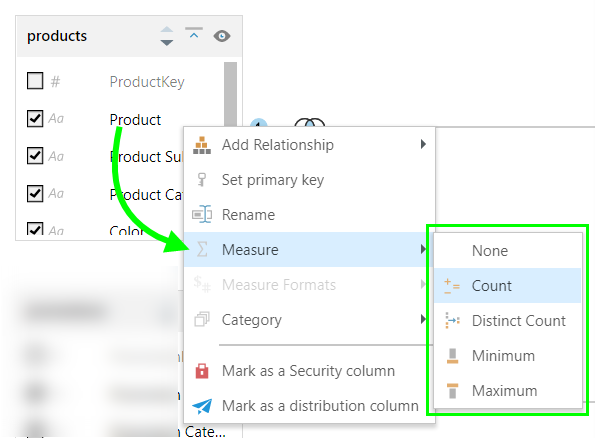Measures
Quantitative data are represented by Measures of values or counts; this data is numeric and can be used for calculations and statistical analysis. Examples of measures include columns like sales, costs, and margin.
Conversely, qualitative data are represented by Members; this data is categorical or descriptive, rather than numeric, and may be represented by a name (such as Bikes) or numeric code (like a transaction ID). Building queries in Discover requires the user to add both measures and members, thereby supplying both the numeric variables and the qualitative variables.
Note: a column does not need to be visible to be used as a measure. In fact, columns used for measures should not be visible in the model. As such, the heuristics in Pyramid that auto select which columns to be used as measures will generally also makes the same column invisible in the model by default. Click here to learn more
Measure Properties
Measure properties are displayed at the bottom of the Properties panel for each column. If the given column has been assigned one or more measures, those will be listed here, along with their metadata. You can delete a measure by clicking its delete icon from here. You can edit a measure by clicking on it to open the Measure Editor, and you can add a new measure by clicking the blue plus sign, which also opens the Measure Editor.
Each measure must have a name, an aggregation, a format, and a measure folder. You also have the option to add a measure description from the Measure Editor; this does not generate any output when the model is processed.

Column Context Menu
Measures can be edited and added from the column context menu. To edit an existing measure from the column context menu, right click on the column; you'll be able to
- Rename the column, which will automatically rename the measure accordingly.
- Change the aggregation.
- Delete the measure by selecting 'None' as the aggregation.
- Change the format by selecting a preset.
- Click here to learn more about the column context menu.

More About Measures
Measure Editor
The Measure editor is used to add measures to columns and edit existing measures. All functions relating to editing and adding measures can be performed here, and several can also be performed from the column context menu.
- Click here to learn more about the Measure Editor.
Measure Types
There are several measure types from which to choose, depending on the data type of the selected column. The selected type will determine how the measure is aggregated when used in a query. For instance, the sum aggregation will add all the values in the column together, while the average aggregation will return the average values. The measure type that you select will largely depend on the kind of data stored in the column, and what the end-users want to know about that data.
- Click here to learn more about Measure Types.
Measure Formats
Pyramid automatically detects measures and assigns a default format to them. Depending on the type of data the measure represents, you may want to change the format. You can select a different format from a list of presets, or enter a custom format.
- Click here to learn more about Measure Formats.
Measure Folders
Pyramid automatically creates measure folders that are labeled according to the table in which they are located. Once the data model is processed, end-users can easily find the required measures within the measure folders. You can change folder names or add new folders in which to store the measures.
- Click here to learn more about Measure Folders.
Multi-Measures
You can assign multiple measure aggregations to a single column, in order to produce multiple measures based on that column. Aggregating a column by multiple measures is useful if end users want to see the data from different perspectives. For instance, there might be an interest in aggregating the Sales column by both the sum and average functions, so that report-builders can add both of these measures to their reports.
- Click here to learn more about Multi-Measures.